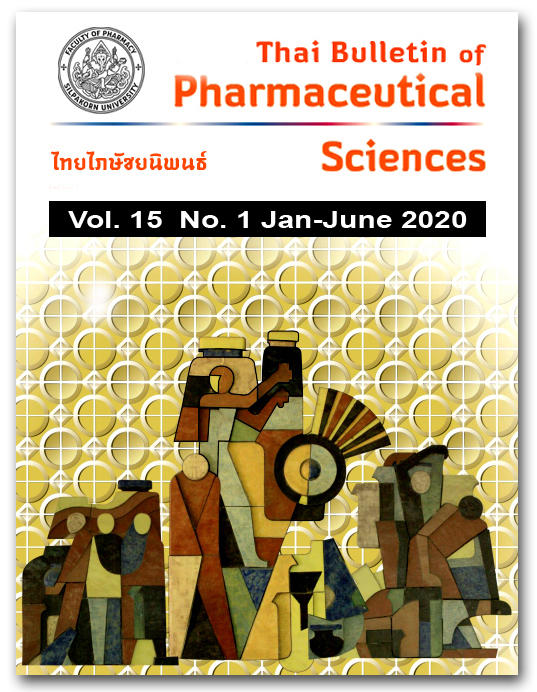CUSTOMER EXPECTATION SURVEY ON THE COMPETENCY OF COMMUNITY PHARMACISTS AND FUTURE SERVICE
DOI:
https://doi.org/10.69598/tbps.15.1.67-80Keywords:
customer expectation, community pharmacy, community pharmacist competency, community pharmacy serviceAbstract
A survey was conducted in Thailand on customer expectation of community pharmacists’ competency and current and future community pharmacy service. A descriptive, cross-sectional questionnaire was used. A nationwide sample of nearly 300 pharmacy customers who entered pharmacies were asked to complete the questionnaire by a community pharmacist. A five-point Likert scale of expectation (1 = least agree to 5 = most agree) with open-ended questions was used. The response rate was 82.33% with the majority of pharmacy customers being female (61.90%). Most of them were company employees, had social security rights, and got services from pharmacy located in Bangkok. Purchasing medications for minor illnesses or treating symptoms was the main purpose of using pharmacy services. The main aspect of community pharmacists and their services was the ability to give advice more than sell medicine (28.48%). According to 3 domains: community pharmacist competency, community pharmacy service, and community pharmacy future service included a total of 43 statements of expectations. The domains’ highest scores were “demonstrate high professional and ethical practice” (4.83 ± 0.45), “do not sell expired and illegal drugs” (4.87 ± 0.47), and “able to refer patients needing intensive care to a hospital” (4.20 ± 0.86), respectively. In conclusion, community pharmacists were expected to be moral and ethical, provide good quality medicine, and facilitate customers’ ease of access to health services.
References
2. Kaew-on P, Lerkiatbundit S, Saengcharoen W. Is there any difference in the quality between the pharmacies accredited by the Pharmacy Council and non-accredited pharmacies? Thai J Pharm Pract. 2012;4(2):39-64. (in Thai)
3. The Office of Community Pharmacy Accreditation (Thailand). History of the Community Pharmacy Development and Accreditation Project [Internet]. Nonthaburi: The Office; c2019 [cited 2019 Nov 22]. Available from: https://papc.pharmacycouncil.org/ index.php?option=aboutus&subpage=history (in Thai)
4. Chokbumrungsuk C, Anuwong K, Poomtong S. The relationship between percieved service quality and service loyalty in drug stores, Bangkok. Thai J Pharm Pract. 2009;1(1):23-33. (in Thai)
5. Ministerial Regulations: The Permission and Approval for Drugstore Type 1 License B.E. 2556 (2013) [cited 2019 Nov 22]. Available from: http://www.fda.moph.go.th/sites/ drug/Shared%20Documents/Law02-Ministerial-regulations/001.PDF (in Thai)
6. Thai VV. Determinants of customer expectations of service: implications for fostering customer satisfaction. Int J Manag Appl Sci. 2015;1(4):146-51.
7. Parinyarux P, Kitikannakorn N. Professional competency for pharmacist in Thailand and other-countries and community pharmacy clerkship in Thailand. Isan J Pharm Sci. 2019;15(3):1-13. (in Thai)
8. Frenk J, Chen L, Bhutta ZA, Cohen J, Crisp N, Evans T, et al. Health professionals for a new century: transforming education to strengthen health systems in an interdependent world. Lancet. 2010;376:1923-58.
9. Charan J, Biswas T. How to calculate sample size for different study designs in medical research? Indian J Psychol Med. 2013;35(2):121-6.
10. Martínez-Mesa J, González-Chica DA, Duquia RP, Bonamigo RR, Bastos JL. Sampling: how to select participants in my research study?. An Bras Dermatol. 2016;91(3):326-30.
11. Food and Drug Administration. Licensed community pharmacies directory 2018 [Internet]. Nonthaburi: FDA; 2018 [cited 2019 Jun 30]. Available from: http://www.fda.moph.go.th/sites/drug/Shared%20Documents/Statistic/Licensee-20181004.pdf (in Thai)
12. Parinyarux P, Wongpoowarak P, Dhippayom T, Laophokhin V, Kitikannakorn N. Community pharmacy competency: systematic review. Thai J Pharm Pract. 2020;12(4):1-11. (in Thai)
13. The Pharmacy Council of Thailand. The Pharmacy Council Announcement; 18 / 2012: Pharmacy core competency of 6-years Pharm D Curriculum [Internet]. Nonthaburi: The Council; 2012 [cited 2019 Nov 22]. Available from: https://www.pharmacycouncil.org/share/file/file_265.pdf (in Thai)
14. Phunarin P, Sriprang S, Srithong K, Chairojkanjana K. The worries and fear of people in Pathum Thani to pharmacies. PYU Journal. 2017;27(1):215-32. (in Thai)
15. Chalongsuk R, Pongcharoensuk P, Lochid-amnuay S. A survey of utilization of pharmacy services by social security beneficiaries in Bangkok and the vicinity. J Health Sci.. 2008;17(1):48-58. (in Thai)
16. Mathurot P. The study of consumer behavior and attitude toward drugstore in Mueang district, Phang Nga province. FDA Journal. 2014;21(1):32-40. (in Thai)
Downloads
Published
How to Cite
Issue
Section
License
All articles published and information contained in this journal such as text, graphics, logos and images is copyrighted by and proprietary to the Thai Bulletin of Pharmaceutical Sciences, and may not be reproduced in whole or in part by persons, organizations, or corporations other than the Thai Bulletin of Pharmaceutical Sciences and the authors without prior written permission.



